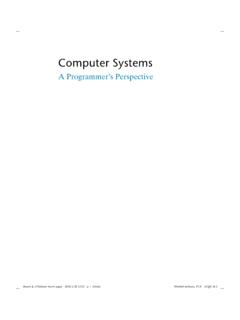Transcription of A Comparison of Hourly Wage Rates for Full- and Part-Time ...
1 bureau OF labor STATISTICSCOMPENSATION AND WORKING CONDITIONSPage 1A Comparison of Hourly Wage Rates for Full- and Part-Time Workers by Occupation, 2007by David M. Pongrace and Alan P. ZilbermanBureau of labor StatisticsOriginally Posted: July 23, 2009 The majority of Full- time workers earn more per hour than Part-Time workers; in some occupations, however, particularly those in healthcare, Part-Time workers earn more per hour than their Full- time are twenty-seven million Part-Time workers in the United States. They may work part time by choice, to supplement their income from a Full- time job, or because Full- time work simply is not an option. Using National Compensation Surveydata, this article will answer questions such as the following: How do Part-Time Hourly wages compare with Full- time Hourly wages? Do the differences in wages vary by occupation? Do these differences vary geographically? By using NCS national and regional wage data to answer these questions, this article provides insight into the wage structure of this sizable part of the Research On NCS Part-Time WagesPrevious studies using NCS data have noted the difference in compensation costs of Part-Time and Full- time workers.
2 In his 1994 analysis of the Employer Costs for Employee Compensation (ECEC) program, Mark A. Brinkley writes, In March 1993, compensation costs for Part-Time workers in private industry averaged $ per hour, compared with $ per hour worked for Full- time workers. 1 Brinkley noted that the employer costs of wages and salaries per hour worked for Full- time workers were higher than that of Part-Time workers; he also found that among the components of compensation cost, the largest differences between Full- time workers and Part-Time workers were for benefit Brinkley compared the overall pay differences between full- and Part-Time workers in all private industry, Michael K. Lettau studied the occupational wage Rates of full- and Part-Time workers in the same establishment. In a December 1994 study,3 Lettau examined data from the Employment Cost Index (ECI), a Principal Federal Economic Indicator, and concluded that Part-Time workers and Full- time workers doing the same job in an establishment do not receive equal pay for the hours worked.
3 He writes, The results suggest that an individual can expect a lower wage rate if he or she decides to work Part-Time rather than Full- time, and much lower benefits per hour. In a March 1999 article in the Monthly labor Review, Lettau and Thomas C. Buchmueller examine benefit costs of Full- time workers and Part-Time Using data from the ECI and the National Compensation Survey Benefits (EBS), the authors conclude that benefit costs are higher for Full- time workers and that Full- time workers have greater access to benefits than do Part-Time findings of these studies are consistent with the notion that, throughout the Nation, Part-Time workers consistently receive relatively less compensation per hour than Full- time workers. The present study examines Hourly wage Rates for Part-Time workers and for Full- time workers at the national and regional level, predominantly focusing on those situations in which Part-Time workers earn more per hour than do their Full- time this study, the authors looked at civilian occupations from the 2007 National Compensation Survey for which there were published wage data for both Part-Time and Full- time positions.
4 Some occupational estimates were available by work level for both full- and Part-Time workers, particularly in healthcare and service occupations. This article focuses on occupational groups without regard to work level. (A study comparing full- and Part-Time workers by work levels would be an interesting topic for further analysis.) The study uses a significance test to determine which occupations show a statistically significant difference in Part-Time Hourly wages and Full- time Hourly bureau OF labor STATISTICSCOMPENSATION AND WORKING CONDITIONSPage 2 Employees are classified in the NCS as part time or full time based on the definitions used by each establishment. The NCS provides data on employer costs for wages and salaries and for benefits, as well as details of employer-provided benefits. Data are shown by sector of the economy (private industry and State and local government), occupational groups, selected worker characteristics (such as full time and part time, and union and nonunion), and establishment characteristics (such as number of employees and geographic area).
5 7 NationwideIn the 2007 NCS national wage bulletin, there are 324 occupations for which average earnings for Part-Time and Full- time workers can be compared. A majority of these occupations (194) revealed a statistically significant difference between Part-Time and Full- time wages. Of these 194 occupations, Full- time workers almost always had higher earnings Rates than Part-Time workers. Part-Time workers had higher wages than Full- time workers in only 12 of the 194 occupations. (See table 1.)Table 1: Mean Hourly earnings for occupations in which Part-Time earnings are greater than Full- time earnings, civilian workers, WorkersPart-time WorkersComputer systems analysts$ $ and architecture teachers, and clinical laboratory practical and licensed vocational and laborers, crop, nursery, and Area DifferencesAs with the national data, when Hourly wage data are broken down by geographic area and occupation, Full- time workers earn more per hour than Part-Time workers.
6 Table 2 shows mean Hourly earnings, by census division, for those occupations in which Part-Time workers earn more per hour than Full- time As can be seen from the table, the most common occupations in which Part-Time workers earn more per hour than Full- time workers are healthcare bureau OF labor STATISTICSCOMPENSATION AND WORKING CONDITIONSPage 3 Table 2: Mean Hourly earnings for occupations in which Part-Time earnings are greater than Full- time worker earnings, by census division, civilian workers, 2007 Census division and occupation (1)All workersFull-time workersPart-time workersEast North CentralPhysicians and surgeons$ $ $ South CentralRegistered AtlanticPhysicians and EnglandClinical laboratory technologists and and kindergarten teachers, except special education teachers, practical and licensed vocational drivers, heavy and AtlanticPhysical sciences teachers, technologists and North CentralMiscellaneous postsecondary and :(1) The West South Central division has no occupations in which Part-Time earnings were greater than Full- time : The States (and the District of Columbia) that comprise the census divisions are: New England: Connecticut, Maine, Massachusetts, New Hampshire, Rhode Island, and Vermont.
7 Middle Atlantic: New Jersey, New York, and Pennsylvania; South Atlantic: Delaware, District of Columbia, Florida, Georgia, Maryland, North Carolina, South Carolina, Virginia, and West Virginia; East South Central: Alabama, Kentucky, Mississippi, and Tennessee; West South Central: Arkansas, Louisiana, Oklahoma, and Texas; East North Central: Illinois, Indiana, Michigan, Ohio, and Wisconsin; West North Central: Iowa, Kansas, Minnesota, Missouri, Nebraska, North Dakota, and South Dakota; Mountain: Arizona, Colorado, Idaho, Montana, Nevada, New Mexico, Utah, and Wyoming; and Pacific: Alaska, California, Hawaii, Oregon, and mentioned previously, very few Part-Time workers earn more per hour than their Full- time counterparts. The number of occupations published in the divisional bulletins in which Part-Time workers earn more than Full- time workers ranges from zero to eight; one census division, West South Central, published none. The number of occupational categories and specific occupations varies across the census divisions because of sample design and publication standards.
8 (See table 3.) bureau OF labor STATISTICSCOMPENSATION AND WORKING CONDITIONSPage 4 Table 3: Occupations with a statistically significant difference between Full- time and Part-Time wage Rates , by geographic area, civilian workers, 2007 Geographic areaTotal number of occupationsPart-time workers earning less than Full- time workersPart-time workers earning more than Full- time workersOccupations in which Part-Time workers earn more per hour than Full- time workersNumber of occupationsAs a percentage of all Part-Time occupationsNumber of occupationsAs a percentage of all Part-Time occupationsUnited workers and laborers, crop, nursery, and greenhouse; Medical and clinical laboratory technologists; Computer systems analysts; Clergy; Engineering and architecture teachers, postsecondary; Therapists; Physical therapists; Speech-language pathologists; Dental hygienists; Licensed practical and licensed vocational nurses; Legal secretaries; Construction laborersEast North and surgeonsEast South nursesMiddle and workers; TherapistsNew laboratory technologists and and Kindergarten Teachers; Preschool teachers, except special education; Registered nurses; Respiratory therapists; Vocational education teachers, postsecondary; Dental hygienists; Licensed practical and licensed vocational nurses; Truck drivers, heavy and tractor-trailerSouth ; Social sciences teachers, postsecondary; Physical therapists; Radiologic technologists and techniciansWest North postsecondary teachers; Waiters and waitressesWest South Central494910000(none) bureau OF labor STATISTICSCOMPENSATION AND WORKING CONDITIONSPage 5 ConclusionThis analysis shows that the majority of Full- time workers earn more per hour than their Part-Time counterparts.
9 These findings are consistent with previous studies and demonstrate that this relationship is true across census divisions nationwide. For many of the divisions, Part-Time workers in healthcare occupations earned more per hour than their Full- time , this finding is not uniform across all healthcare M. PongraceEconomist, Division of Compensation Data Analysis and Planning, Office of Compensation and Working Conditions, bureau of labor : (202) 691-6204; E-mail: P. ZilbermanEconomist, Division of Compensation Data Analysis and Planning, Office of Compensation and Working Conditions, bureau of labor : (202) 691-5179; E-mail: See Mark A. Brinkley, Employer Costs for Employee Compensation to Include Information on Part-Time and Full- time Workers, Compensation and Working Conditions, June Ibid, p. Michael K. Lettau, Compensation in Part-Time Jobs Versus Full- time Jobs: What if the Job is the Same?, bureau of labor statistics (BLS) Working Paper 260, Office of Research and Evaluation, December 1994; available on the Internet at Michael K.
10 Lettau and Thomas C. Buchmueller, Comparing Benefit Costs for Part-Time and Full- time Workers, Monthly labor Review, March 1999, pp. 30-35; available on the Internet at Jerome E. King examined the differences between Part-Time and Full- time wage Rates in terms of density of Part-Time workers within occupational category, ratios of benefit costs to total compensation, and other measures. He found marked compositional differences by occupation between private industry and State and local government. He also found that Part-Time workers received a higher percentage of their total compensation in wages and salaries than did Full- time workers, and that Part-Time workers in the health field typically received higher average Hourly earnings than did their Full- time counterparts. See Part-Time Workers Earnings: Some Comparisons, Compensation and Working Conditions, Summer 2000, pp. 27-36; available on the Internet at The authors tested the difference of the standard errors of Full- time and Part-Time mean wages, at a significance level of , to determine whether an occupation had a significantly higher wage for Part-Time workers than for Full- time workers.















